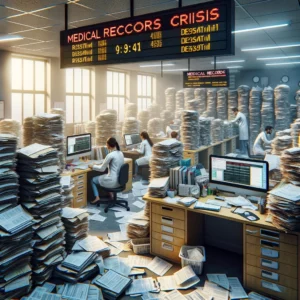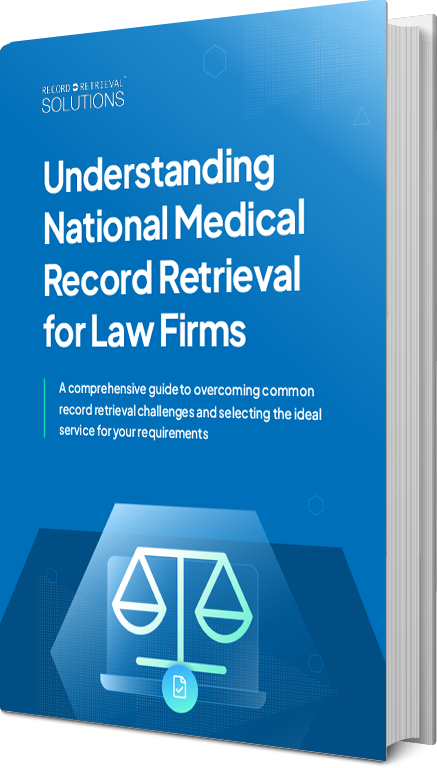In the dynamic world of healthcare, the management and maintenance of patient health records have hit a critical bottleneck. A combination of increasing patient numbers, the swift transition towards digital health records, and a notable gap in skilled professionals has ushered in what many are calling a medical record staffing crisis. This crisis is not just a temporary setback but a growing concern that threatens the efficiency, accuracy, and confidentiality of healthcare delivery across the board. Moreover, it poses a significant hurdle in the sector’s journey towards embracing more advanced technologies like electronic health records (EHRs) and telemedicine.
Understanding the Medical Record Staffing Crisis
The heart of the crisis lies in a simple yet alarming reality: there is a severe shortage of skilled professionals capable of efficiently managing and maintaining patient health records. This shortage stems from a variety of factors, each compounding the issue further. As healthcare facilities grapple with an upsurge in patient numbers, the demand for digital health records skyrockets, leaving the industry scrambling for a solution amidst a dwindling pool of trained personnel.
This predicament not only breeds inefficiencies in healthcare delivery but also increases the likelihood of inaccuracies in patient records. Perhaps even more concerning is the heightened risk of breaches in patient confidentiality, a cornerstone of patient trust and safety. The staffing crisis also significantly impedes the healthcare sector’s ability to adapt and evolve with emerging technologies, such as EHRs and telemedicine, which are critical for modernizing healthcare services and improving patient outcomes.
Factors Contributing to the Medical Record Staffing Crisis
Increasing Demand for Medical Records Staff
The medical record staffing crisis is exacerbated by several factors that collectively contribute to the increasing demand for skilled professionals in the field. Among these, the technological revolution within healthcare plays a significant role. The digitization of health records has not only transformed how patient data is stored and accessed but has also significantly increased the volume of data to be managed. This digital transition requires a workforce that is not only proficient in traditional record-keeping practices but also skilled in navigating electronic health record (EHR) systems, ensuring data privacy, and analyzing digital health information. The rapid pace of technological advancements often outstrips the current workforce’s ability to adapt, creating a gap between the demand for and supply of qualified medical records staff. Moreover, the implementation of new health information technologies demands continuous learning and adaptation, further intensifying the pressure on the existing workforce and making the recruitment of new talent with requisite skills a pressing need.

Compounding the situation, demographic shifts, such as an aging population and the prevalence of chronic diseases, have led to an exponential increase in the need for healthcare services. This surge amplifies the amount of medical documentation required, pushing the demand for medical records staff to unprecedented levels. Each patient interaction generates a multitude of data points that need to be accurately recorded, managed, and preserved, adding to the workload of medical records departments. Additionally, regulatory requirements for meticulous documentation and the growing emphasis on data-driven care further stretch the capabilities of medical records staff. These factors, combined with the healthcare sector’s expansion into new service models like telehealth, have created a perfect storm, significantly increasing the demand for medical records staff and contributing to the staffing crisis. Addressing these challenges requires a multifaceted approach, focusing on education, training, and the adoption of technologies that can alleviate the burden on medical records professionals.
Technological Advancements
Technological advancements are at the forefront of reshaping the healthcare landscape, particularly in how medical records are managed and utilized. The transition to Electronic Health Records (EHRs) and the increasing reliance on digital tools for patient care have fundamentally changed the skill set required for medical records management. This evolution demands professionals who are not only proficient in healthcare documentation but also skilled in software use, data analysis, and cybersecurity. As technology continues to advance, the gap between the available workforce and the demand for technologically adept staff widens, exacerbating the medical record staffing crisis. The rapid pace of digital transformation in healthcare, while offering numerous benefits in terms of efficiency and patient care outcomes, also presents a significant challenge in recruiting and retaining staff capable of navigating these complex systems.
Furthermore, the integration of artificial intelligence (AI), machine learning, and big data analytics into healthcare processes places additional pressure on the medical records field. These technologies offer the potential to improve patient outcomes, streamline operations, and provide insights into public health trends, but they also require specialized knowledge to implement and manage effectively. The scarcity of professionals trained in these cutting-edge technologies contributes to the staffing crisis, as the industry struggles to keep pace with these advancements. Healthcare organizations find themselves in a competitive race not only against each other but also against other industries vying for the same pool of tech-savvy talent. This competition, coupled with the rapid evolution of technology in healthcare, highlights the critical need for strategic initiatives focused on education, training, and workforce development to bridge the technological proficiency gap in medical records management.
High Turnover Rates
High turnover rates among medical records staff pose a significant challenge to healthcare organizations, exacerbating the staffing crisis in this essential sector. This phenomenon is largely attributed to the demanding nature of the job, which often involves long hours, high volumes of data to manage, and the stress associated with ensuring accuracy and confidentiality in patient records. The intense pressure to maintain a high level of precision in documenting patient care can lead to job dissatisfaction and burnout, prompting staff to seek employment in less demanding environments or different industries altogether. The cycle of recruitment, training, and eventual departure of staff places a continuous strain on healthcare facilities, not only in terms of financial costs but also in maintaining the consistency and quality of patient care documentation.
Moreover, the high turnover rates in medical records management are indicative of broader issues within the healthcare industry, including inadequate support systems for staff wellbeing, lack of career advancement opportunities, and insufficient recognition of the critical role that records management plays in patient care. The COVID-19 pandemic further intensified these challenges, as medical records staff faced additional workload and stress due to the surge in patient numbers and the need for meticulous documentation of COVID-19 cases. To address the high turnover rates, healthcare organizations must prioritize strategies aimed at improving working conditions, offering professional development opportunities, and enhancing job satisfaction among medical records staff. Investing in technology that streamlines record management processes can also reduce the workload and alleviate some of the stress factors contributing to turnover, ultimately helping to stabilize the workforce in this vital sector.
The Shrinking Workforce
The shrinking workforce in medical records management is a critical factor contributing to the ongoing staffing crisis, rooted in several interrelated issues. Aging demographics within the profession itself mean that a significant portion of the workforce is reaching retirement age, leading to a depletion of experienced professionals in the field. This situation is compounded by the challenge of attracting new talent; the medical records management profession struggles to compete with other sectors that may offer more appealing compensation, benefits, and working conditions. Additionally, there is a noticeable lack of qualified graduates entering the field, partly due to a mismatch between the curricula offered by educational institutions and the evolving needs of the healthcare industry, particularly in terms of technological proficiency and data management skills.
To compound these challenges, the competition for skilled labor is not just within the healthcare sector but also with industries outside healthcare that value data management and analysis skills. This broader competition makes it even harder for healthcare organizations to attract and retain talent, especially in a job market that increasingly values flexibility, work-life balance, and opportunities for advancement. Addressing the shrinking workforce issue requires a multifaceted approach, including reevaluating compensation and working conditions in healthcare, enhancing visibility and attractiveness of careers in medical records management, and aligning educational programs more closely with the current and future needs of the healthcare sector. By tackling these issues, the healthcare industry can begin to mitigate the staffing crisis and ensure a stable, skilled workforce to manage the critical task of medical records management.
Training and Education Gaps
Training and education gaps significantly contribute to the medical record staffing crisis, representing a key bottleneck in the pipeline of skilled professionals entering the field. As the healthcare industry rapidly evolves, particularly with the integration of electronic health records (EHRs) and advanced data analytics, the existing curricula often fall short of equipping students with the necessary skills and knowledge. This discrepancy between the educational offerings and the industry’s needs leads to a workforce that, although eager, may not be fully prepared for the complexities of modern medical records management. The transition from paper-based systems to digital platforms requires not just familiarity with new software but a comprehensive understanding of data security, privacy laws, and the ability to analyze and leverage health information. Without adequate training and education in these areas, new graduates may find it challenging to meet the demands of their roles, impacting healthcare organizations’ ability to maintain efficient and secure record-keeping practices.
Moreover, the rapid pace of technological advancement in healthcare means that ongoing education and professional development are crucial for the existing workforce. However, opportunities for such development can be scarce, especially in resource-constrained settings, leading to a skills gap even among seasoned professionals. This situation is exacerbated by budget constraints that limit healthcare organizations’ ability to invest in training and development programs for their staff. Addressing these training and education gaps requires a concerted effort from educational institutions, healthcare organizations, and policymakers to develop and implement curricula that are in line with the current and emerging needs of the healthcare sector. Additionally, fostering a culture of continuous learning and providing access to ongoing professional development opportunities are essential steps towards mitigating the medical record staffing crisis and ensuring the healthcare industry can adapt to the digital age.
Budget Constraints
Budget constraints play a significant role in the medical record staffing crisis, acting as a primary factor that hinders healthcare organizations from maintaining an adequate workforce. In an era where healthcare costs are continually rising, many institutions face financial pressures that force them to make difficult decisions regarding resource allocation. The tight budgets often mean that salary offers for medical record staff are not competitive enough to attract and retain qualified professionals. Additionally, limited financial resources can lead to a freeze on hiring, even as the demand for medical record management grows with the increasing patient loads. This financial tightrope not only impacts the ability to staff these critical positions but also affects the overall efficiency and effectiveness of healthcare delivery.
Moreover, budget constraints affect the investment in necessary technology and training programs that could otherwise help mitigate the impact of staffing shortages. Advanced electronic health record (EHR) systems and automation technologies hold the promise of streamlining medical record management processes, yet the upfront and ongoing costs associated with these technologies are often prohibitive for facilities operating under stringent budgetary limitations. Without the ability to invest in these technological advancements, healthcare organizations find themselves stuck in a cycle of manual record management, requiring more staff than budgets allow. This creates a paradox where the lack of investment in technology due to budget constraints exacerbates the very staffing crisis that technology could help alleviate.
The Burden of COVID-19
The COVID-19 pandemic has significantly exacerbated the medical record staffing crisis, presenting unprecedented challenges to healthcare systems worldwide. The sudden surge in patient volumes, coupled with the need for meticulous documentation of COVID-19 cases, placed an immense burden on medical record departments already strained by pre-existing staffing shortages. The pandemic highlighted the critical importance of accurate and timely medical records in managing public health crises, yet it also pushed the limits of what thinly stretched staff could handle. As healthcare facilities scrambled to respond to the emergency, the demand for medical record management skyrocketed, further deepening the staffing crisis. The increased workload not only heightened the stress and burnout among existing staff but also made it more challenging to recruit new personnel amid health concerns and the increased risk of exposure to the virus.
Furthermore, the COVID-19 pandemic accelerated the transition to telehealth services, which, while beneficial for patient care continuity, introduced additional complexities in record management and documentation. The need to integrate digital health records from telehealth platforms with traditional in-person visit documentation added another layer of complexity to the already demanding workload of medical record staff. This shift demanded rapid adaptation and further emphasized the shortage of skilled personnel equipped to manage the evolving landscape of healthcare documentation. The pandemic, thus, not only intensified the immediate strain on medical record departments but also underscored the urgent need for systemic changes to address the staffing crisis, highlighting the importance of resilience and flexibility in healthcare infrastructure.
A System Under Strain

The crisis is not just about staffing shortages; it’s about a system under immense strain. Inefficient workflows, outdated technology, regulatory pressures, and a lack of investment in staff training and development all contribute to the burgeoning crisis, making it a multifaceted challenge that requires a comprehensive and strategic response.
The medical record staffing crisis is a stark reminder of the essential role these professionals play in the healthcare ecosystem. Addressing this crisis requires a concerted effort from all stakeholders, including healthcare facilities, educational institutions, and policymakers, to ensure that the healthcare system remains resilient, efficient, and capable of meeting the needs of patients now and in the future.
Conclusion
The medical record staffing crisis poses significant challenges for legal professionals, impacting the efficiency, cost, and reliability of medical record retrieval. To mitigate these effects, there’s a need for collaborative efforts between healthcare providers, legal professionals, and educational institutions to address the staffing shortages, improve training programs, and enhance the overall management of medical records.







